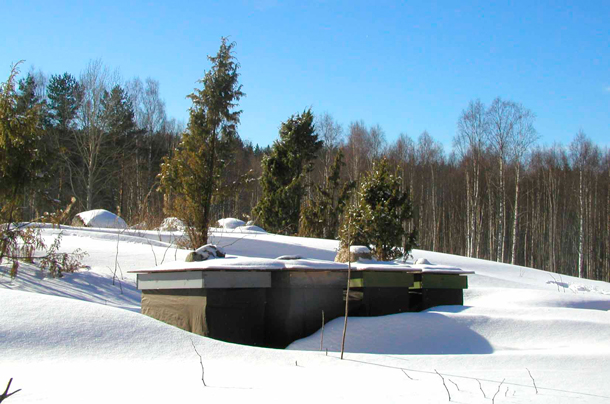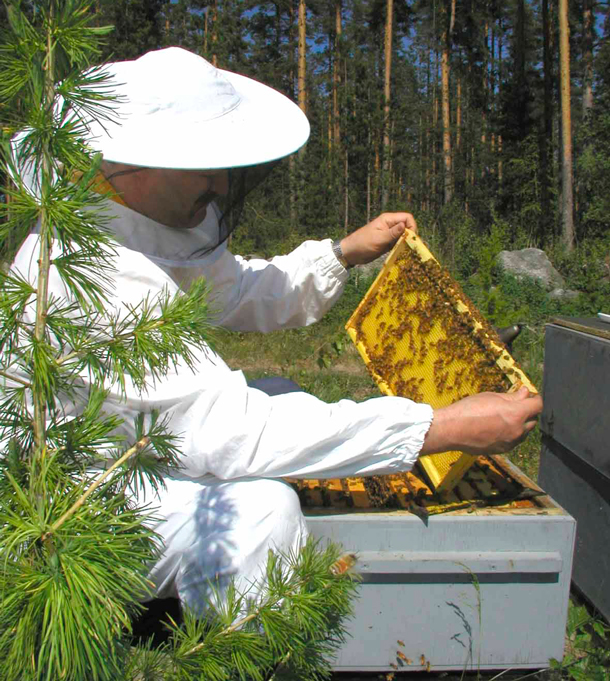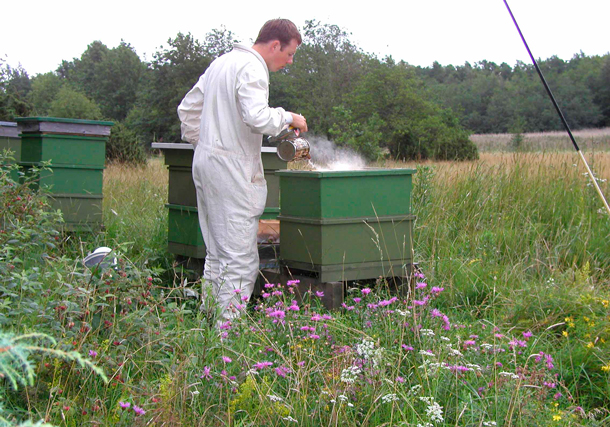The Bee Year
THE BEE YEAR:
AUTUMN AND WINTER
From a beekeeper’s viewpoint, the bee year can be considered to begin in late summer after the harvest, once the queen’s egg laying is over for that summer, and the bees begin to prepare for their winter rest. At this point, the beekeeper’s duty is to take care of the winter feeding and to get the hive ready for the winter. The honey that has been collected is replaced with a sugar solution, which the bees then use to prepare and to store a honey-like solution for their food. The sugar must be placed in the hive early enough for the bees to have time to cover the food cells with a wax lid, which ensures that the food will keep.
Once the feeding is completed, the bees are left in peace until even daytime temperatures have fallen under 5oC and the bees no longer fly outside. At this stage, the flight entrances are sealed against mice and other small animals, and in particular hives that are in open areas are protected from the wind and the snow. After this, the hives are not touched before the spring, but every now and then it is necessary to check whether cold winds or wild animals have caused any destruction. During the winter, the beekeeper cleans and updates the hive equipment, and makes purchases and plans for the next spring and summer.
DID YOU KNOW: The bees that hibernate are the queen bee and the last-born workers of the summer, approximately 20 000 in one hive. The bees hibernate in a winter cluster, first in the lower part of the hive and then they move in pursuit of their food. In other words, they open up new cells and move on to the upper part of the hive. The temperature in the inner parts of the cluster is approx. 20oC, and there the bees can move around and eat. The bees that are on the outer circle of the cluster keep tightly together and produce warmth.
SPRING
Once the temperature in spring rises to 8-10oC, the flight entrances are opened and the bees are let out on a cleansing flight, in other words to defecate, after the break that has lasted all winter. Normally, bees do not defecate in their hive in the winter and since, however, they eat a lot, their emptying need is considerable in the spring.
The growing of larvae normally begins on a small scale already in February and it increases towards the spring. It begins properly in April once the weather gets warmer and the bees are able to replenish their pollen stores again. When spring begins, the winter bees are nearing the end of their lifecycle, and normally there are more of them dying than there are new ones being born, so the population of the hive can fall up until May. When beekeepers make their first inspection at the beginning of May, they also clean the base of the hive, they check that the temperature is high enough for the larvae to grow, they place the additional feeding frame and, if needed, they change the order of the compartments. At this stage, it is also necessary to start monitoring the number of varroa destructors, in other words, mites. This is best done with a mite-monitoring plate that is placed under the hive, and the number of mites that are found there will indicate the need for preventative measures.
The situation of the hives is checked once a week and sufficient nourishment is ensured. Additional nourishment should always be provided for the hive during cold or very rainy weather to ensure that the development is not disturbed due to lack of food. The swarming season begins at the end of May and normally lasts until mid July. Swarming is the natural way for bees to reproduce and to expand their habitat, as the old queen and the old bees move from the hive to a new place and the young bees stay in the old hive and grow themselves a new queen. For beekeepers, swarming means a decrease in honey producers. Therefore, they have to aim to keep the hives in such condition that will make the bees stay and feel comfortable in them.
DID YOU KNOW: The varroa destructor was originally a parasite that attacked only a bee breed that was accustomed to it and the parasite caused hardly any harm. Once human beings began to mix the bee breeds, the mite spread to bees that could not defend themselves against it, and this mite became one of the major causes of the mass death of bees during the winter. The varroa lays eggs in the larvae cells and destroys, or at least harms, the larvae. The mites bite grown bees and cause cuts that become infested by pathogens, some of which cause even worse damage than the mites themselves. Hives that have been subjected to mites for several years are no longer strong enough for hibernation, and the damaged bees cannot tend to the hive.
SUMMER
Once the number of bees significantly increases in June, additional compartments must be added to the hives for the maturing and the storing of honey. The easiest way to expand is to add one compartment on top of the hive. This additional compartment should have ready-built combs in it as well as unbuilt wax bases.
The production of larvae is at its peak in the middle of the summer and it gradually decreases after that. The population reaches its peak naturally when the larvae have become adults within three weeks. The number of bees is at its highest approx. 8-10 weeks after the intense larvae production has begun, and in an ideal situation, this is also the time for the main harvest season. With springtime beekeeping measures, it is possible to have some impact on when the larvae production begins and when the population reaches its peak. The harvest season in Finland lasts approx. 3-4 weeks, and towards the end of that it is possible to check whether there is already enough covered honey ready for collection. By mid August, all of the honey is collected and the hives are prepared for autumn feeding. Once the weather begins to get cold again, the worker bees drive the drones out of the hive, and preparations for the next winter begin – one bee year is over.




